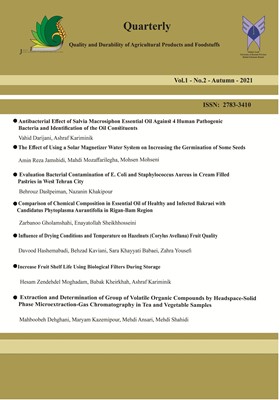Antibacterial effect of Salvia macrosiphon essential oil against 4 human pathogenic bacteria and identification of the oil constituents
Subject Areas : Traditional medicine
Ashraf Kariminik
1
*
![]() ,
Vahid Darijani
2
,
Vahid Darijani
2
1 - Assistant professor, Department of Microbiology, Kerman Branch, Islamic Azad University, Kerman, Iran
2 - M.S, Department of Microbiology, Kerman Branch, Islamic Azad University, Kerman, Iran
Keywords: chemical constituents, antibacterial effect, Salvia macrosiphon Essential oil,
Abstract :
In many parts of the world, there is a rich tradition in the use of herbal medicine for the treatment of many infectious diseases. Because of the side effects and the resistance that pathogenic microorganisms build against the antibiotics, much recent attention has been paid to extract the biologically active compounds from plant species used in herbal medicine. The aim of this study was antibacterial activity of Salvia macrosiphon essential oil on four bacteria and identification of the chemical constituents. The essential oil was extracted using hydro-distillation method and analyzed by GC, GC/MS.The total number of compounds identified and quantified were 10 representing 92.8 % of the total essential oil. Linalool (54.8%) and sclareol (27.3%) were the major compounds. The antimicrobial activity of the oil was evaluated using dilution method against standard strains of Bacillus cereus, Staphylococcus aureus. Escherichia coli and Salmonella enterica. All of the bacteria were sensitive to the oil. Minimum bactericidal concentration of the oil on S. aureus, B. cereus, Escherichia coli and S. enterica were 0.15, 0.15, 0.38 and 0.77% respectively. The obtained results confirm and suggested the justification of indigenous plant, Salvia macrosiphon essential oil used in traditional medicine as treatment for microbial infections or as preservative in food.
1- Alvarez-Martínez FJ, Barrajón-Catalan E, Encinar JA, Rodríguez-Díaz JC, Micol V. Antimicrobial capacity of plant polyphenols against gram-positive bacteria: A compreh-ensive review. Current medicinal chemistry. 2020;27(15): 2606-2576.
2- Atanasov AG, Waltenberger B, Pferschy-Wenzig EM, Linder T, Wawrosch, C, Uhrin P, Temml V, Wang L, Schwaiger S, Heiss EH, Rollinger JM. Discovery and resupply of pharmacologically active plant-derived natural products: A review. Biotechnology advances. 2015;33(8): 1614-1582.
3- Raja RR. Medicinally Potential Plants of Labiatae (Lamiaceae) Family: An Overview. Research Journal of Medicinal Plant. 2012; 6:203-213.
4- Sarac N, Ugur A. Antimicrobial activities and usage in folkloric medicine of some Lamiaceae species growing in Mugla, Tur-key. Eur Asian Journal of Biosciences. 2007; 1:28-34.
5- Gohari AR, Ebrahimi H, Saeidnia S, For-uzani M, Ebrahimi P, Ajani Y. Flavones and flavone glycosides from Salvia macrosiphon Boiss. Iranian Journal of Pharmaceutical Re-search. 2011;10:247-251. [In Persian]
6- Kahraman A, Celep F, Dogan A. new rec-ord for the flora of Turkey: Salvia macr-osiphon Boiss. (Labiatae). Turkish Journal of Botany. 2009;33: 53-55.
7- Akhgar MR, Rajaei P, Poshteshirani F. Composition of the essential oil of Zygop-hyllum eurypterum from Iran. Chemistry of Natural Compounds. 2015;51:577-578. [In Persian]
8- Kariminik A, Moradalizadeh M, Foroughi MM, Tebyanian H, Motaghi MM. Chemical composition and antibacterial activity of the essential oils extracted from 4 medicinal pla-nts (Labiatae) of Kerman, Iran. Journal of Applied Biotechnology Reports. 2019;6(4): 172-179. [In Persian]
9- Matloubi-Moghddam F, Moridi-Farimani M, Taheri S, Tafazoli M, Amin G. Chemical constituents from Salvia macrosiphon. Che-mistry of Natural Compounds. 2008;44:518-519.
10- Adams R. Identification of essential oil components by gas chromatography/quadru-pole mass spectroscopy. Allured, Carol Stre-am, IL, USA. 2007.
11- Al-Mariri A, Safi M. The Antibacterial activity of selected Labiatae (Lamiaceae) essential oils against Brucella melitensis. Ira-nian Journal of Medical Sciences. 2013;38: 44-50. [In Persian]
12- Trong Le N, Viet Ho D, Quoc Doan T, Tuan Le A, Raal A, Usai D, Madeddu S, Marchetti M, Usai M, Rappelli P, Diaz N. In vitro antimicrobial activity of essential oil extracted from leaves of Leoheo domatio-phorus Chaowasku, DT Ngo and HT Le in Vietnam. Plants. 2020;9(4):453.
13- Moosavy MH, Hassanzadeh P, Moham-madzadeh E, Mahmoudi R, Khatibi SA, Mardani K. Antioxidant and antimicrobial activities of essential oil of Lemon (Citrus limon) peel in vitro and in a food model. Journal of food quality and hazards control. 2017;4(2):42-48.
14- Tepe EJ, Vincent MA, Watson LE. Piper: A model genus for studies of phyt-ochemistry, ecology, and evolution. Kluwer Academic Publishers; Phylogenetic patterns, evolutionary trends and the origin of ant-plant associations Piper section Macrosta-chys: Burger’s hypotheses revisited. 2004; 156-178.
15- Bajpai VK, Baek KH, Kang SC. Control of Salmonella in foods by using essential oils: a review. Food Research International. 2012;45:722-734.
16- Javidnia K, Miri R, Jamalia A. Comp-osition of the essential oil of Salvia macros-iphon Boiss. from Iran. Flavour and Fragr-ance Journal. 2005;20:542-543.
17- Matloubi-Moghddam F, Amin G, Safa-vi-Poorsohi, E. Composition of stem bark essential oil from Salvia macrosiphon Boiss. DARU Journal of Pharmaceutical Sciences. 2000; 8:28-29.
18- Rowshan V, Karimi S. Essential oil composition and allelopathic effect of Salvia macrosiphon Boiss. on Zea mays L. Interna-tional Journal of Agriculture. 2013;3:788-794.
19- Hedayati A, Mirjalili MH, Hadian J. Chemical diversity in the essential oil from different plant organs of Salvia sahendica Boiss. & Buhse. Journal of Plant Research (Iranian Journal of Biology). 2017;29(4): 908-918. [In Persian]
_||_
